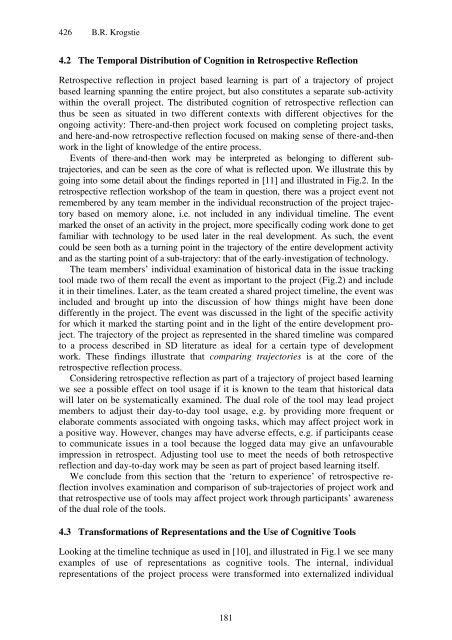The work-reflection-learning cycle - Department of Computer and ...
The work-reflection-learning cycle - Department of Computer and ...
The work-reflection-learning cycle - Department of Computer and ...
You also want an ePaper? Increase the reach of your titles
YUMPU automatically turns print PDFs into web optimized ePapers that Google loves.
426 B.R. Krogstie<br />
4.2 <strong>The</strong> Temporal Distribution <strong>of</strong> Cognition in Retrospective Reflection<br />
Retrospective <strong>reflection</strong> in project based <strong>learning</strong> is part <strong>of</strong> a trajectory <strong>of</strong> project<br />
based <strong>learning</strong> spanning the entire project, but also constitutes a separate sub-activity<br />
within the overall project. <strong>The</strong> distributed cognition <strong>of</strong> retrospective <strong>reflection</strong> can<br />
thus be seen as situated in two different contexts with different objectives for the<br />
ongoing activity: <strong>The</strong>re-<strong>and</strong>-then project <strong>work</strong> focused on completing project tasks,<br />
<strong>and</strong> here-<strong>and</strong>-now retrospective <strong>reflection</strong> focused on making sense <strong>of</strong> there-<strong>and</strong>-then<br />
<strong>work</strong> in the light <strong>of</strong> knowledge <strong>of</strong> the entire process.<br />
Events <strong>of</strong> there-<strong>and</strong>-then <strong>work</strong> may be interpreted as belonging to different subtrajectories,<br />
<strong>and</strong> can be seen as the core <strong>of</strong> what is reflected upon. We illustrate this by<br />
going into some detail about the findings reported in [11] <strong>and</strong> illustrated in Fig.2. In the<br />
retrospective <strong>reflection</strong> <strong>work</strong>shop <strong>of</strong> the team in question, there was a project event not<br />
remembered by any team member in the individual reconstruction <strong>of</strong> the project trajectory<br />
based on memory alone, i.e. not included in any individual timeline. <strong>The</strong> event<br />
marked the onset <strong>of</strong> an activity in the project, more specifically coding <strong>work</strong> done to get<br />
familiar with technology to be used later in the real development. As such, the event<br />
could be seen both as a turning point in the trajectory <strong>of</strong> the entire development activity<br />
<strong>and</strong> as the starting point <strong>of</strong> a sub-trajectory: that <strong>of</strong> the early-investigation <strong>of</strong> technology.<br />
<strong>The</strong> team members’ individual examination <strong>of</strong> historical data in the issue tracking<br />
tool made two <strong>of</strong> them recall the event as important to the project (Fig.2) <strong>and</strong> include<br />
it in their timelines. Later, as the team created a shared project timeline, the event was<br />
included <strong>and</strong> brought up into the discussion <strong>of</strong> how things might have been done<br />
differently in the project. <strong>The</strong> event was discussed in the light <strong>of</strong> the specific activity<br />
for which it marked the starting point <strong>and</strong> in the light <strong>of</strong> the entire development project.<br />
<strong>The</strong> trajectory <strong>of</strong> the project as represented in the shared timeline was compared<br />
to a process described in SD literature as ideal for a certain type <strong>of</strong> development<br />
<strong>work</strong>. <strong>The</strong>se findings illustrate that comparing trajectories is at the core <strong>of</strong> the<br />
retrospective <strong>reflection</strong> process.<br />
Considering retrospective <strong>reflection</strong> as part <strong>of</strong> a trajectory <strong>of</strong> project based <strong>learning</strong><br />
we see a possible effect on tool usage if it is known to the team that historical data<br />
will later on be systematically examined. <strong>The</strong> dual role <strong>of</strong> the tool may lead project<br />
members to adjust their day-to-day tool usage, e.g. by providing more frequent or<br />
elaborate comments associated with ongoing tasks, which may affect project <strong>work</strong> in<br />
a positive way. However, changes may have adverse effects, e.g. if participants cease<br />
to communicate issues in a tool because the logged data may give an unfavourable<br />
impression in retrospect. Adjusting tool use to meet the needs <strong>of</strong> both retrospective<br />
<strong>reflection</strong> <strong>and</strong> day-to-day <strong>work</strong> may be seen as part <strong>of</strong> project based <strong>learning</strong> itself.<br />
We conclude from this section that the ‘return to experience’ <strong>of</strong> retrospective <strong>reflection</strong><br />
involves examination <strong>and</strong> comparison <strong>of</strong> sub-trajectories <strong>of</strong> project <strong>work</strong> <strong>and</strong><br />
that retrospective use <strong>of</strong> tools may affect project <strong>work</strong> through participants’ awareness<br />
<strong>of</strong> the dual role <strong>of</strong> the tools.<br />
4.3 Transformations <strong>of</strong> Representations <strong>and</strong> the Use <strong>of</strong> Cognitive Tools<br />
Looking at the timeline technique as used in [10], <strong>and</strong> illustrated in Fig.1 we see many<br />
examples <strong>of</strong> use <strong>of</strong> representations as cognitive tools. <strong>The</strong> internal, individual<br />
representations <strong>of</strong> the project process were transformed into externalized individual<br />
181
















